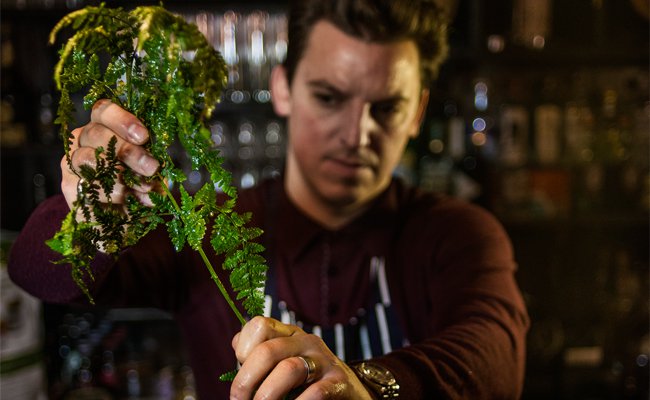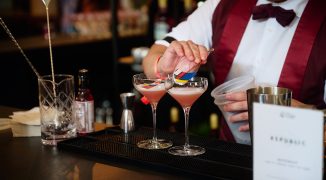With 70 percent of the United Kingdom’s gin produced there, gin is booming in Scotland right now. That number includes not only the big names like Tanqueray, Gordon’s and Hendrick’s, but also a growing number of craft gins. Inspired by a renewed countrywide focus on celebrating local and artisanal ingredients, Scotland’s producers are experimenting with the bounty of the country’s natural larder. The result is that each distillery, from Speyside to the Shetlands, creates a hyper-regional product with a flavor profile that carries with it something of the area from which it came.
Highlands
The fresh air and pristine water of the Scottish Highlands undoubtedly affect the clean, crisp gins it produces. Adding their own influence are botanicals sourced throughout the region. For Caorunn, a handcrafted gin launched in 2009, five wild, local botanicals are hand-picked within a 10 minutes’ walk of the distillery, in the traditionally whisky-producing Speyside region. Highlanders traditionally foraged these botanicals –rowan berry (“caorunn” in Gaelic), bog myrtle, dandelion, heather and coul blush apple – for their healing properties, and the subtle aroma can’t help but conjure up images of the wild, heather-strewn Highlands. “With Caorunn, we have distilled the Scottish Highlands into a glass,” says master distiller Simon Buley.
Rock Rose Gin comes from Caithness in the very far north of Scotland. Searnbucktho comes from the distillery gardens, and rowan berries, hawthorn berries and water mint from Dunnet forest, a mile away. While these botanicals are common across the Highlands, it is the addition of a more difficult to source botanical, the rhodiola rosea (rose root), hand-foraged from the north coast cliffs overlooking the Pentland Firth, that adds something unique, giving the gin a distinctly floral nose with a light earthy taste.
Islands
Inextricably linked to whisky production, the Scottish islands are now also making a name for themselves in the gin world. On the island of Islay, Bruichladdich whisky distillery turned heads in 2010 when it launched the island’s first gin, The Botanist Islay Dry Gin, made with 22 local botanicals foraged from across Islay. More recently, and further north, the Shetland Isles got their first legal distillery in 2014. Shetland Reel Gin is produced in the U.K’s most northerly distillery on Unst – the U.K.’s most northerly inhabited island. The gin is marketed as having a “unique Shetland twist” thanks to the inclusion of apple-mint, which is grown on the island and adds a fruity note.
And it doesn’t stop there. The remote Western Isles, on the very edge of Scotland, are set to have their first gin, too. While waiting for their single malt whisky, Hearach, to mature, Isle of Harris distillers will soon release Isle of Harris Gin, infused with hand-dived sugar kelp. Traditionally used by the island’s crofters to fertilize the soil, the seaweed will bring a saltiness to the gin, evoking some of the maritime influence of the Outer Hebrides.
Edinburgh and the Lothians
Launched in 2010, Edinburgh Gin opened a distillery, complete with visitor center and gin bar, in the city center in 2014. This summer they released a limited edition Seaside Gin, featuring bladderwrack seaweed, scurvy grass and ground ivy, all sourced from the beaches near North Berwick, around half an hour east of Edinburgh. “We collected a lot of weird, local, edible things,” says brand ambassador Ewan Angus, “and then brought them back to distill.” The bladderwrack adds a mineralistic salinity that sweetens with the addition of tonic. It’s the seaweed that really transports the drinker to the wild and windy East Lothian seaside, Angus says: “It’s got a really evocative taste.”
Fife
In Fife — where both Tanqueray and Gordon’s are produced — Eden Mill distillery, just outside St. Andrews, uses local botanicals grown by the St. Andrews University Botanical Gardens (among others). The producers forage for additional botanicals, “which allows us to reflect the different seasons of St. Andrews in our gins” says Shona Gillespie, brand ambassador. “The sea buckthorn berries for our classic Eden Gin are grown right on our doorstep in the Eden Estuary. We tend to do seasonal gins, which work well for the time of year and also mirror the type of season St Andrews has had: our first batch of Love Gin used elderberries which were less sweet in flavor than the current batch, as we are now using berries picked at a warmer time of year.”
Angus
Somewhat off the usual tourist path, Angus, in the northeast of Scotland, has recently been making a name for itself through its craft gins. Deep in the misty Angus Glens, The Gin Bothy creates handmade gins infused with the fresh local berries the region more traditionally uses for jams and marmalades.
Arbikie Distillery, on the coast, have just launched Kirsty’s Gin, named after the master distiller Kirsty Black, who says she “spent quite a while researching plants that grow naturally in Scotland that could also potentially lend a positive flavor or aroma to a gin.”Kirsty’s Gin features three botanicals that grow wild locally and are added with the intention of capturing three elements surrounding the distillery: the sea, the rock and the land. “Kelp is everywhere on this wild coastline,” says Black who notes an almost sherbet character to the flavor, “so it had to be an important botanical. The sea is a presence that envelops our distillery.” Representing the rock, the bitter, earthy Carline thistle is a shoreline plant with a distinctive daisy-like flower, it grows close by in the rocky areas surrounding the spectacular bay the distillery overlooks. Blaeberries, which represent the land, are abundant around the distillery.





